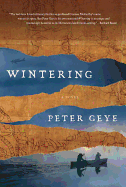
| Publisher: | Knopf | |
| Genre: | Fiction, Family Life, Action & Adventure, Literary | |
| ISBN: | 9781101946466 | |
| Pub Date: | June 2016 | |
| Price: | $26.95 |
| Fiction |
by Peter Geye
In his second novel, The Lighthouse Road (after Safe from the Sea), Minneapolis novelist Peter Geye introduced the Norwegian immigrant Eide family living in Minnesota's Lake Superior town of Gunflint. Wintering continues the saga of the Eides' next generation, beginning as the elder, dementia-stricken Harry Eide wanders off one day into the wilderness to the north. Prompted by Harry's disappearance, his middle-aged son, Gus, thinks back to the winter when he was 18 and joined his father on a long canoe trek to the same Canada/Minnesota borderlands of the Laurentian Divide. Like Faulkner's Yoknapatawpha County, the imaginative Lake Superior north shore of Geye's three novels is a world of its own--colorful, provincial and buttoned-up.
Wintering's narrator, Berit Lovig--Harry's late-in-life lover, long-time local postmistress, and for 40 years the caretaker of Gus's reclusive, cantankerous grandmother--knows much of Gunflint's complicated history. She tells Gus, "This town has always been good at having secrets, and terrible at keeping them." As Gus tells his story to Berit and she tells hers to him, Geye's assured narrative gradually unfolds a Jack London-like tale of survival blended with a Richard Russo-like picture of small-town intrigue.
Gus's memory of the uncharted lands far beyond the Devil's Maw rapids is at the center of Wintering, but Berit's perspective on her own past and that of the other immigrants arriving at Gunflint's port is an equally compelling history of patience and endurance. Geye dips into history with ease and comes out with a story as contemporary as anything flashing across our screens today. Wintering is a novel for the ages. --Bruce Jacobs, founding partner, Watermark Books & Cafe, Wichita, Kan.

| Publisher: | Putnam | |
| Genre: | Fiction, Romance, Romantic Comedy, Contemporary Women, Contemporary | |
| ISBN: | 9781101982471 | |
| Pub Date: | June 2016 | |
| Price: | $26 |
| Fiction |
by Liz Kay
In poet and small press editor Liz Kay's first novel, Monsters: A Love Story, Omaha, Neb., is the home of recently widowed Stacey Lane, mother of two grade-school boys and author of the feminist novel-in-verse Monsters in the Afterlife--a retelling of the Frankenstein story featuring a woman monster and highlighting, as she describes it, "gender ideals and sexual power dynamics." Despite its slight first printing and obvious political agenda, it implausibly catches the eye of sexy Hollywood actor Tommy DeMarco, who has his go-to assistant contact Stacey and fly her to the Turks and Caicos to negotiate buying the film rights, retaining her as a screenwriter. And just like that, Stacey drops her boys at her homemaker sister's house and flies to Hollywood to hammer out a filmable script--and into the seductive, womanizing star's bed.
But who's seducing whom? Kay's protagonist is no star-smitten bimbo just off the bus. She has to fight the director to keep the movie true to her poetic vision while he reminds her that "people go to poetry to expand their minds and sh*t. They go to the movies to be entertained... the ending to this thing isn't even dark, it's f*cking bleak. It makes me want to blow my brains out."
Stacey is a complicated woman trying to sort out the conflicting tugs of motherhood, professional success and personal satisfaction. Monsters: A Love Story is a smart, satirical feminist novel but, as the subtitle suggests, it's also a romance. If it doesn't change your life, it is nonetheless a diverting fantasy about how that just might happen. --Bruce Jacobs, founding partner, Watermark Books & Cafe, Wichita, Kan.

| Publisher: | Simon & Schuster | |
| Genre: | Fiction, Romance, Romantic Comedy, Literary, Magical Realism | |
| ISBN: | 9781501126222 | |
| Pub Date: | June 2016 | |
| Price: | $25.99 |
| Fiction |
by Steven Rowley
Steven Rowley's first novel, Lily and the Octopus, is a startling, scintillating experience, both funny and emotionally wrenching: a story that shatters all expectations.
In the opening lines, narrator Ted Flask introduces his contented home life with his domestic partner, an aging dachshund named Lily. They live in Los Angeles, where Ted works from home, and they are comfortable in their routines: pizza on Sundays, Monopoly on Fridays, talking about cute boys on Thursdays. They have inside jokes, holiday traditions, and an idyllic story of love at first sight. Lily holds up her end of conversations, although as a dog she is of course distractible, and her memory can be short. Her voice is just as we expect a dog to sound. As a puppy (in flashbacks, as in the scene of their first meeting), her breathless enthusiasm comes out in all caps and exclamation points: "IT'S! A! GREAT! TIME! TO! BE! ALIVE!"
As the novel unfolds and Ted fills out as a character, though, it becomes clear that his life is not necessarily well-rounded. He has a therapist he dislikes; he finds her dim-witted, and in his head runs all her advice past his ideal, imaginary therapist. He has panic attacks. His career has stalled. A long-term relationship, ended 18 months ago, continues to haunt him; recent attempts at dating have gone poorly. Until Lily, he worried that he was unable to open up, unable to love. In Ted's favor, he has a superlative human best friend named Trent, who always comes when called and brings Valium. And, crucially, Ted has Lily. She is the best thing in his disordered and inwardly-turned life.
Those first sentences introducing Lily also introduce the octopus. A new addition to their household, he has a death grip on Lily's head, and he's not going anywhere. Like Lily, the octopus talks. Ted wants him to leave, but the octopus will not let Lily go. She begins to have seizures. She weakens.
Ted dreams of an octopusectomy. The vet offers chemotherapy, radiation and surgery, but is not optimistic about Lily's chances. Ted tries to involve her in the decision-making, but Lily is a dog: her attention span is limited (oh look, red ball!) and, anyway, at 12-and-a-half human years, she has been feeling a little run-down. She rarely speaks in caps anymore. Ted was warned by a vet that, as Lily aged, she would begin to exhibit what he called Enclosed World Syndrome; that is, her perceived world and realm of interest would shrink. It is true, her walks have gotten shorter. Of course, Ted himself has the same malady. As the octopus's tentacles tighten around Lily's precious small head, Ted realizes he has a battle on his hands.
It is easy to fear that the market for books about beloved dogs may be flooded, but this one does something new. Lily and the Octopus is its own beast, and the reader is not the same person at the end as at the beginning. In many ways this is the story of Steven Rowley's life in all its emotional truth, if not in specific, literal details. Ted and Lily's Los Angeles is a thoroughly realistic setting, but a few elements--most obviously the talking octopus--offer boggling departures. By relying on metaphor, Rowley creates a fantasy world with touches of magical realism, somehow both more affecting and more comforting than reality.
Lily and the Octopus comes with the trappings of humor, canine antics, strong characters and profound emotions. Rowley, who is also a screenwriter, peppers the story with Cate Blanchett, Ryans Gosling and Reynolds, Bradleys Cooper and Milton. Equally prominent are the literary references: Kipling's jungle, Auden's "Funeral Blues," and a reading list to prepare for an octopus hunt: Hemingway, Melville, Patrick O'Brian. The book opens in the spirit of a fun read, but the tone quickly deepens to a sadder and a more intense experience. Ted and Lily's story centers around relationships: love and life partnership, the nature of commitment and of loss, and what it looks like to fight for one's friends. As Ted battles the octopus and tries to shore up his darling, he ends up examining every aspect of his own life, his own shortcomings and the strengths he discovers in himself, almost by surprise. His journey, then, is not only about a man and his dog but about breaking out of life's stalemates. This introspection and interior aspect to the novel is only one of the depths that make it both more than another story about a beloved dog, and more than a whimsical work of fantasy--although it is a superb example of both.
Lily and the Octopus is literary and raw, and relentlessly heartfelt. Questions of who and how we love are at its center and, vitally, the question of how we part. Imaginative, ever-astonishing, suspenseful and wise, Rowley's surprising novel is thoroughly gut-wrenching, but well worth the pain. With a winning dog at its robust heart, no reader could ask for more. --Julia Jenkins

| Publisher: | Viking | |
| Genre: | General, Crime, Fiction, Police Procedural, Mystery & Detective, Westerns | |
| ISBN: | 9780525429593 | |
| Pub Date: | June 2016 | |
| Price: | $26 |
| Mystery & Thriller |
by Keith McCafferty
Featured in Keith McCafferty's four previous Montana crime novels (including 2016 Spur Award-winning Crazy Mountain Kiss), Sean Stranahan is still living the western fantasy life: watercolor artist, fishing guide, private detective and regular at the Trout Tails Bar and Grill, which features a topless mermaid swim tank. When part-time mermaid Ida Evening Star hires him to find her childhood friend John Running Boy, the case entangles Stranahan with his ex-lover Sheriff Martha Ettinger, who is investigating the bloody scene of an apparent re-enactment of the ancient Plains Indian practice of pishkun--herding bison over a cliff to harvest their meat, skins and bones to sustain the tribe over a long winter. At the bottom of the Palisades scree, she finds the body of a young Blackfeet man, disemboweled, with a handmade arrow in his thigh. The murder victim was last seen with John Running Boy and two wealthy white brothers from Dartmouth. Together, Stranahan and Ettinger follow the clues through southwestern Montana's complicated politics, involving state DOL agents, National Park Service rangers, anti-bison ranchers, save-the-bison evangelists, bureaucrats and disenfranchised Native Americans.
An editor of Field & Stream, McCafferty knows the locals, the landscape and the legends, as well as his Montana literary antecedents ("Tom McGuane, James Welch, A.B. Guthrie, William Kittredge, Ivan Doig, Richard Hugo... more drinking and depression on this shelf than in the whole of Ireland"). But mostly he knows how to tell a good story, and Buffalo Jump Blues is a solid addition to the Stranahan saga. --Bruce Jacobs, founding partner, Watermark Books & Cafe, Wichita, Kan.
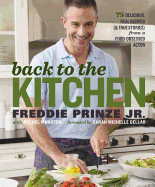
| Publisher: | Rodale | |
| Genre: | Regional & Ethnic, American - General, General, American - Southwestern States, Cooking, Entertaining, Cooking with Kids | |
| ISBN: | 9781623366926 | |
| Pub Date: | June 2016 | |
| Price: | $27.50 |
| Food & Wine |
by Freddie Prinze Jr.
Actor Freddie Prinze Jr. is a talented cook who's spent a lifetime making food for the people he loves and works with. Raised in Albuquerque, N.Mex., by his mother, and summering in Puerto Rico with his late father's family, Freddie grew up surrounded by vibrant flavors. The food he creates is clearly inspired by New Mexican and Puerto Rican flavors, and his passion for sharing his love of cooking with his own kids is a reflection of an upbringing where he was taught to appreciate food and the cooking process.
Back to the Kitchen is a great cookbook, chock-full of gorgeous photographs, simple recipes and fun stories from his acting career--like when Freddie cooked pans of green chile chicken enchiladas for the cast and crew of Buffy the Vampire Slayer while visiting his wife, Sarah Michelle Gellar, on set. His daughter, Charlotte, is his biggest kitchen assistant, and several of her favorite recipes--including "Charlie's Dessert"--are included.
With dishes including The Rock's Cinnamon Pancakes; Roasted Chicken with Lemon, Lime, Orange and Mexican Beer; and Mushroom Risotto Made Easyish, Freddie's no-nonsense approach to satisfying meals will make home cooks want to try everything, while the mouthwatering photographs of each recipe will keep the reader's stomach growling. And the cute pictures of his kids in the kitchen and his often-repeated mantra about the importance of passing on your interests to your children just might inspire other parents to start cooking with their kids. --Jessica Howard, blogger at Quirky Bookworm
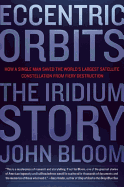
| Publisher: | Atlantic Monthly Press | |
| Genre: | General, Mobile & Wireless Communications, History, Technology & Engineering, Aeronautics & Astronautics, Corporate & Business History, Business & Economics | |
| ISBN: | 9780802121684 | |
| Pub Date: | June 2016 | |
| Price: | $27.50 |
| Business & Economics |
by John Bloom
John Bloom's Eccentric Orbits does for the 1990s birth of the satellite phone industry what Tracy Kidder's Soul of a New Machine did for the next-generation computer business. It's a wild story about the rise and fall and rise again of Motorola's Iridium network--a colossal business gamble, massive bankruptcy and remarkable rebirth. Texas journalist Bloom, aka redneck movie critic persona Joe Bob Briggs (Joe Bob Goes to the Drive In), combed newspaper archives, patent filings, stock offering memoranda, NASA records, bankruptcy documents and transcribed interviews to spin his tale of corporate hubris and groundbreaking science. With a deep cast of characters, Eccentric Orbits is like George Lucas's Star Wars saga--complicated, seemingly never-ending and thrilling.
Motorola was the world leader in cell phones when the basic idea for Iridium took shape in 1987. With one gigantic engineering undertaking, Motorola saw a way to solve two mobile phone problems: eliminate "dropped calls" whenever phones lost contact with cell towers and side-step the huge cost and logistical nightmare of covering the earth with more towers. Its solution: launch 77 (the atomic number of the element iridium) non-equatorial Low Earth Orbit satellites to blanket the globe with phone coverage.
Bloom is an exhaustive reporter with a knack for choice metaphors and skewed descriptions. He dips into the scientific details of space aeronautics and orbit algorithms, and explains the technology behind all those cell phone acronyms like GSM and CDMA that few people understand. Funny, informative, exciting, Eccentric Orbits is the kind of business book that should be turned into one of those movies that Joe Bob Briggs likes to review. --Bruce Jacobs, founding partner, Watermark Books & Cafe, Wichita, Kan.
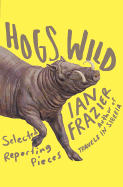
| Publisher: | Farrar, Straus & Giroux | |
| Genre: | Literary Collections, Social Science, Poverty, Essays | |
| ISBN: | 9780374298524 | |
| Pub Date: | June 2016 | |
| Price: | $26 |
| Essays & Criticism |
by Ian Frazier
In On the Rez and Travels in Siberia, Ian Frazier offered idiosyncratic musings on isolated communities--culturally or geographically--and the odd, fascinating people that live within them. Hogs Wild: Selected Reporting Pieces is a diverse collection of essays and journalistic pieces that maintains that central focus, while also demonstrating Frazier's boundless, endearing curiosity and his ability to draw humor and strange flashes of insight from the most unlikely of sources.
The title essay manages to be both exceptionally unusual and entirely indicative of Frazier's style and concerns. Few other writers would choose wild hogs as a likely vector for a discussion of the United States' culturally divided landscape, but he does so with an extended tangent on the correlation between the number of wild hogs in a state and support for President Bush in the 2004 election. Or, as Frazier puts it: "Wild hogs seem to be everywhere that the red-state red can't get any redder and starts to turn into a Confederate flag." These off-the-wall observations are par for the course for Frazier, who seems to follow his every fleeting thought to its frequently humorous, occasionally moving conclusion. Consider, for example, "Hungry Minds," which focuses on a writing workshop that he operated adjacent to a church-based soup kitchen. He writes about his students: "Somehow, writing even a few lines makes the person who does it more substantial and real."
In the case of Hogs Wild, it's Frazier's writing that makes depressive fishermen, generals who died perversely underappreciated, the victims of Hurricane Sandy and many more remarkable individuals substantial and real. --Hank Stephenson, bookseller, Flyleaf Books
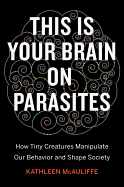
| Publisher: | Eamon Dolan/Houghton Mifflin Harcourt | |
| Genre: | Physical, Anthropology, Evolutionary Psychology, Parasitology, Psychology, Social Science, Medical, Microbiology, Life Sciences, Science | |
| ISBN: | 9780544192225 | |
| Pub Date: | June 2016 | |
| Price: | $27 |
| Science |
by Kathleen McAuliffe
Early in science journalist Kathleen McAuliffe's book concerning the impact of parasites on evolutionary biology, she recounts the brutalities that the jewel wasp inflicts during its life. After stunning the American cockroach with a paralysis-inducing sting and performing a form of "brain surgery" on the animal, inhibiting its ability to process information or react, the wasp guides the unfortunate, enslaved insect into a hole, lays some eggs on the roach's leg, and leaves it to be devoured alive by freshly hatched wasp larvae. Almost all life is predicated on the taking of other lives for survival in some fashion, but this and other anecdotes are powerful reminders of the sheer terror of the natural world. And they are among the strongest elements of This Is Your Brain on Parasites.
McAuliffe's fascinating thesis argues that the extent of host manipulation by parasitic organisms is significantly greater than previously understood. Parasites large (e.g., the jewel wasp) and small (e.g., Toxoplasma gondii) may even be influencing human political, cultural and religious developments as they seek to achieve their reproductive and survival aims. McAuliffe, though, notes one researcher's caveat after studying the effects of bacteria on the brain: "We have to be cautious in how we interpret the results." Readers are well served to heed such cautions: while the science discussed supports this thesis, much is still early and controversial.
McAuliffe is particularly adroit at discussing studies and narrating parasite lifecycles. These accomplishments alone make her work worth reading; the implications, even more so. "Indeed, we are more microbe than human. There is no I--only we." --Evan M. Anderson, collection development librarian, Kirkendall Public Library, Ankeny, Iowa

| Publisher: | W.W. Norton | |
| Genre: | United States, History, Technology & Engineering, Military, Research & Methodology, Science, Military Science | |
| ISBN: | 9780393245448 | |
| Pub Date: | June 2016 | |
| Price: | $26.95 |
| Starred | Science |
by Mary Roach
Mary Roach (Stiff, Gulp, Packing for Mars) investigates the seedy underbelly of military operations with her trademark tongue-in-cheek aplomb. She provides an eye-opening exposé of government research projects that (at times) appears almost fantastical.
Her research begins at the U.S. Army Natick Soldier Research, Development and Engineering Center, where scientists and fashionistas are hard at work creating new ways for soldiers to stay dry, sated and bulletproof in the heat of battle. At the Aberdeen Proving Grounds, Roach witnesses how officers conduct personnel vulnerability tests, or "the art and science of keeping people safe in a vehicle that other people are trying to blow up," using crash test dummies (donated "stiffs") to assess the vulnerabilities of armored vehicles. Grunt then travels inward, to the gross-out elements of human bodily parts and functions, as she delves into male urogenital reconstruction and penile transplants for injured veterans in one chapter, and diarrheal threats to national security in "Leaky Seals." Fittingly, Roach goes on to observe government efforts to create a stink bomb so noxious as to discourage enemy combatants, and any marine predators, from attacking downed pilots.
While Roach imbues her storytelling with a quick wit, she is also swift to point out the more lasting consequences of war: "Despite or possibly because of their low profile, the less visible injuries of war can be the hardest kind to have." Nevertheless, Grunt is certain to arouse a more than passing interest in the tax dollars at work on these secret government research projects. --Nancy Powell, freelance writer and technical consultant
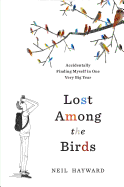
| Publisher: | Bloomsbury | |
| Genre: | Animals, Biography & Autobiography, Essays, Birds, Personal Memoirs, Nature | |
| ISBN: | 9781632865793 | |
| Pub Date: | June 2016 | |
| Price: | $28 |
| Starred | Nature & Environment |
by Neil Hayward
After quitting his executive job, Neil Hayward found himself drifting professionally and personally. He didn't want to travel the world or start a business--but he did suddenly have more time to devote to his longtime passion, birding. As he struggled with depression and his fear of committing to a new romance, Hayward spent more and more time behind his binoculars. He charts his birding adventures--and his almost-accidental pursuit of a record-breaking Big Year--in his memoir, Lost Among the Birds.
Hayward hadn't planned on doing a Big Year, a birder's quest to see as many species as possible in a calendar year. His spur-of-the-moment April start meant he would spend eight months catapulting around the country, sleeping in his car and surviving largely on granola bars. Although the Big Year included endless hours on airplanes and some frustrating near-misses, Hayward lived for the joy he found in sighting each new bird. "The birding was my salt... that essential amino acid I couldn't get from anywhere else," he explains. "It gave me life and reminded me that I was part of life." Along the way, he found community among his fellow birders, and his depression slowly began to lift.
With precise, lovely descriptions of birds and dry, self-deprecating wit, Hayward recounts his journey through unfamiliar terrain both personal and geographical. Birders and non-birders alike will relate to his search for fulfillment and his delight in "the simple joy that comes from seeing the unexpected." --Katie Noah Gibson, blogger at Cakes, Tea and Dreams

| Publisher: | Crown | |
| Genre: | United States, General, State & Local - General, Ecosystems & Habitats, History, Environmental Conservation & Protection, Wilderness, Law, 20th Century, Legal History, Nature | |
| ISBN: | 9780307454263 | |
| Pub Date: | June 2016 | |
| Price: | $28 |
| Nature & Environment |
by Jordan Fisher Smith
In 1972, a young man was mauled to death by a bear in Yellowstone. The ensuing civil trial provides the frame for Engineering Eden, Jordan Fisher Smith's compelling history of wildlife conservation in the United States. At issue is whether the National Park had done enough to prevent such an attack. This in turn raises the question of whether humans can--or should--control nature. This philosophical question is the pounding heart of Smith's inquiry.
The trial, though, takes something of a backseat as Smith--author of Nature Noir and a former park ranger--methodically lays out the relevant history of ecological philosophy and practice. "Yellowstone was not created as a wildlife refuge," he points out. "It was a tourist attraction that began functioning like one." The prose is more Erik Larson than Aldo Leopold. The most dramatic chapters are not the courtroom scenes, but rather ones in which biologists and conservationists spar with policymakers and sometimes each other.
How much intervention does nature require? If left alone, will it return to a virgin state? To what degree should tourists interact with wildlife? And to what degree are we liable for our mistakes? With Engineering Eden, Smith has pulled off an amazing feat: he's made wildlife management urgent and engrossing, writing about it with clarity, depth and a storyteller's pacing.
The issues are timeless. On the centennial of the National Park Service, this book is an outstanding introduction to ecological decision-making. --Zak Nelson, writer and editorial consultant
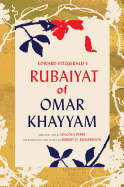
| Publisher: | Bloomsbury | |
| Genre: | Epic, Poetry, Ancient & Classical | |
| ISBN: | 9781620406564 | |
| Pub Date: | June 2016 | |
| Price: | $20 |
| Poetry |
by Robert Richardson, editor, illust. by Lincoln Perry
Anyone fearful that this edition of Edward Fitzgerald's The Rubaiyat of Omar Khayyam is an unnecessary new translation of the Persian poet can rest easy. Annotated by Robert Richardson and published in conjunction with Nearer the Heart's Desire, Richardson's dual biography of Omar Khayyam and Edward Fitzgerald, this is instead a celebration of Fitzgerald's loose translation and an arrangement of Khayyam's verse into a unified narrative.
Richardson would be the first to argue that a new translation would be beside the point, describing Fitzgerald's version as a "silk road of the mind"--linking the two poets across time and space. Since its original publication in 1859, Fitzgerald's version of the Rubaiyat has been translated into numerous languages and appeared in more than 1,300 editions. Although it has been, in Richardson's words, "condescended to in a variety of ways" by critics and scholars alike, The Rubaiyat remains enduringly popular in a way that few works of poetry have.
The Bloomsbury edition is a delight. Richardson opens with a brief essay that is both personal and scholarly. His annotations are done with a light hand, and the poetry is illuminated by the work of artist Lincoln Perry. Previous artists have depicted the action of the narrative in an Orientalist style; Perry combines graceful silhouettes of roses and vine leaves with bold images of hands in action to reflect the volume's major themes. This is a Rubaiyat that will please longtime fans and new readers alike. --Pamela Toler, blogging at History in the Margins
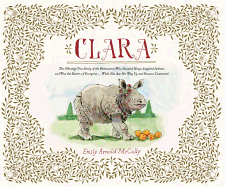
| Publisher: | Schwartz & Wade/Random House | |
| Genre: | Animals, Juvenile Fiction, Europe, Hippos & Rhinos, Historical | |
| ISBN: | 9780553522464 | |
| Pub Date: | June 2016 | |
| Price: | $17.99 |
| Starred | Children's & Young Adult |
by Emily Arnold McCully
Three hundred years ago, Europeans from Vienna to Versailles who wanted to know what a rhinoceros looked like were out of luck. In this fascinating (mostly) true story, the white-wigged Dutch Captain Van der Meer decides to buy his old friend's household pet--a motherless, "tame," India-born rhino named Clara--and take her on tour by horse-drawn wagon and by sea to show her off and make a buck.
Caldecott Medalist Emily Arnold McCully (Mirette on the High Wire) tells the tale with charm and wit, and her delightful pen-and-ink and watercolor illustrations of the sweetly expressive Clara and her "beautiful soul" will have readers falling for the rhino, too. The captain, in hopes of attracting ticket-buyers, prints promotional posters: "SHE HAS SKIN LIKE SEASHELLS, EARS LIKE AN ASS, CAN SWIM LIKE A DUCK, AND IS AS TAME AS A DOVE. SHE EATS 100 POUNDS OF HAY AND 30 LOAVES OF BREAD A DAY AND DRINKS 14 BUCKETS OF WATER AND BEER." The good-natured, 5,000-pound Clara captures the imagination of Paris in particular: "Hairdressers created the style à la rhinoceros... Gowns à la rhinocéros were worn to balls.... The French navy even christened a new ship La Rhinocéros. It was Rhinomania!"
The way McCully imagines it, man and beast form a bond thicker than rhino skin in their 17 years together, and this moving friendship is the core of Clara. An author's note and maps help sort fact from fiction, and gently contextualize the animal-exploitation angle that's sure to spark some valuable discussions. A great story with a big rhino heart. --Karin Snelson, children's & YA editor, Shelf Awareness

| Publisher: | Clarion/Houghton Mifflin Harcourt | |
| Genre: | General, Fantasy & Magic, Action & Adventure, Juvenile Fiction, Historical | |
| ISBN: | 9780544301801 | |
| Pub Date: | June 2016 | |
| Price: | $16.99 |
| Children's & Young Adult |
by Karen Cushman
Newbery author Karen Cushman (The Midwife's Apprentice; Catherine, Called Birdy), best known for her historical fiction, makes her first foray into fantasy with Grayling's Song, set in a magical, medieval England.
Grayling is an obedient, hardworking girl who lives in a thatched cottage with her mother, a healer who trades charms and tonics for hams and coats. Grayling privately rails against the relentless tyranny of the mother she both loves and fears. But when their cottage bursts into flames and her mother is, shockingly, turned into a tree by some invisible evil, it's up to Grayling to take charge. Neither brave nor gifted with magic herself, she must head out into the "strange and dangerous" world and sing her mother's "gathering song" to summon the wizards, hags and soothsayers who might know how to break the curse. It must be true that "summat wicked be in the kingdom," as the townspeople suggest.
"Tangles and toadstones!" as Grayling would say: her very first night on the road, a mouse unwittingly eats all of her potions, including the shape-shifting one, and that is how the mouse/goat/raven she calls "Pook" joins her entourage. Grayling also befriends the ancient weather witch Auld Nancy, the "troublous" runny-nosed Pansy, the alluring enchantress Desdemona Cork and the gnarled fortuneteller Sylvanus Vetch who sees the future via... cheese. Readers will revel in Cushman's atmospheric, witty tale of Grayling's risky and rambling rescue mission across the countryside that ultimately transforms her from a cowed, timid girl to a healer and leader who discovers her own powers. --Karin Snelson, children's & YA editor, Shelf Awareness